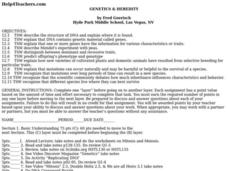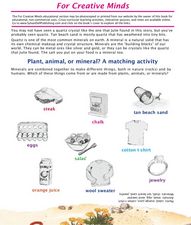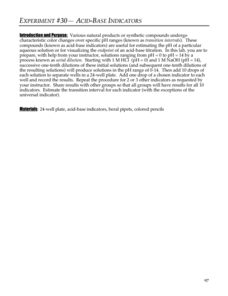Curated OER
Magnetism: What is a Magnetic Field?
Students make a compass. In this magnetism lesson, students use the Internet to research magnetic fields and perform an experiment to find the magnetic fields around different magnets. Students use the Internet to research...
Curated OER
Denaturing Proteins
High schoolers investigate how to denature proteins. In this denaturing protein lesson plan, students explore the different ways to denature proteins in the lab. They use heat, acids and bases, organic compounds and heavy metals to...
Curated OER
Laboratory: Modeling Molecular Shapes
In this molecules worksheet, students answer post lab questions about types of bonds, factors that determine polarity and molecular geometry. They calculate electronegativity differences in atoms and determine the types of bonds between...
Curated OER
Applied Science - Physics Post-Lab
Students investigate energy. In this Physics lesson plan, students explore different sources of energy: heat, nuclear, and chemical. Students sing an electricity song.
Curated OER
Motion in Fluids
Students explore physical science by participating in a science activity. In this liquids lesson, students discuss how fluids can be affected by motion unlike solids. Students define other scientific vocabulary terms and conduct a motion...
Curated OER
Phototaxis
Young scholars conduct lab experiment to answer the question: How will starving Dictyostelium Discoideum Slugs respond to white light? They determine whether the slugs are attracted to or repelled by the light.
Curated OER
Genetics and Heredity
Students study genetics and heredity. They explore the structure of DNA and genes through a series of activities that includes watching videos, conducting online research, and making vocabulary books. They investigate DNA, genetics,...
Curated OER
Genetics and Heredity
Students explore genetics and heredity. They study meiosis and view videos and create vocabulary flashcards. They create a graphic organizer that compares and contrasts sexual and asexual reproduction in each of the six kingdoms. They...
Curated OER
For Creative Minds
Students study pictures of plants, animals, and minerals. Students classify the pictures into the three groups. In this rock identification lesson, students complete a rock finding lab experiment by finding, cleaning, identifying, and...
Curated OER
Liver
Students study the livers parts and functions then follow a lab experiment to watch first hand how the gut uses bile to physically break down fatty substances into smaller pieces.
Curated OER
Week 3: Pollution Source and Effects
Lab groups set up an experiment to observe what happens over time in collected pond water when fertilizer, representing pollution, is added. This website does not include student lab sheets, but background information, materials, and...
Curated OER
Energy Efficiency Ambassadors
Definitely for high schoolers, this lesson is an open-ended exploration of energy efficiency. Groups of two to three junior environmental engineers design an experiment to test for efficiency. They prepare a full lab report and...
Curated OER
Investigating Properties of Water: Temperature
Investigate how temperature affects the density of water and stratification that occurs in bodies of water when temperatures vary. Water of differing temperatures is given different colors to see the layers that form. The lesson is meant...
Curated OER
Pendulums
First-time physicists experiment with pendulums in this physics lesson. They vary the weight of the bob, record how long each takes to complete ten period swings, and then calculate the time for one period. They repeat the procedure,...
Curated OER
Strong Ice
Through three activities, first-time physical scientists wonder at the properties of water. Freeze some soda cans and a container of water prior to the investigation to show that water expands when frozen. Lab groups experiement with...
Curated OER
Understanding Chemical Reactions Lesson: Bonds and Energy
What is required to get a chemical reaction? Chemistry learners find out by viewing this slide show. They will be able to compare endothermic and exothermic reactions, as well as draw energy level diagrams for each. A lab activity is...
Science 4 Inquiry
The Yin and Yang of Photosynthesis: Day vs. Night
Floating fragments of elodea can grow even without roots. Young scientists use eldoea plants to observe the oxygen production from photosynthesis. They study the difference between having access to high amounts of light and low amounts...
Polar Trec
Is There Salt in a Glacier?
What can conductivity tell us about a glacier? Groups analyze glacial melt to determine salt content through an analysis of the pH and conductivity measurements of two samples. Groups then determine the source of the salts.
Beyond Benign
SLS Toxicology Test
Ingredients in your shampoo are toxic enough to kill plants. The 16th installment of the series of 24 tests the toxicity level of various concentrations of SLS, a chemical found in nearly all shampoo. Learners prepare percent solutions...
Curated OER
Hazards: Second Grade Lesson Plans and Activities
Equip learners with safety knowledge in the case of an earthquake. After coloring the places to go to get help after a quake, and label places that wouldn't be safe to go after a quake, young geologists simulate three levels of...
Howard Hughes Medical Institute
Winogradsky Columns: Microbial Ecology in the Classroom
Winogradsky columns are ideal for observing the role of bacteria and other microorganisms in an ecosystem. This student activity guide is complete with data tables for observations and analysis questions for processing what was observed....
Space Awareness
Oceans as a Heat Reservoir
Oceans absorb half of the carbon dioxide and 80 percent of the greenhouse gases released into the atmosphere. Scholars learn how and why the oceans store heat more effectively than land and how they help mitigate global warming. Pupils...
Pingry School
Acid-Base Indicators
Acid-base indicators are an essential part of any chemistry classroom. Individuals explore the color-changing feature of the important indicators in a vibrant hands-on activity. Using serial dilution, learners create solutions ranging...
University of Minnesota
Connect the Neurons!
Create a neuron frenzy as your pupils play the part of the neurons. An engaging lesson plan creates a human chain of neurons that pass cotton balls posing as neurotransmitters. Scholars learn about pre- and post-synapses as they...























